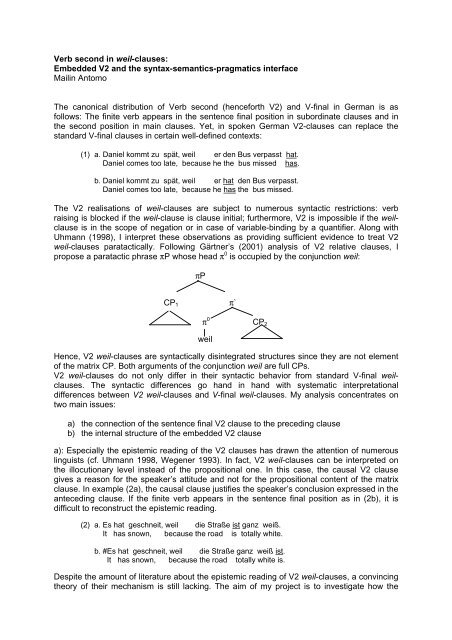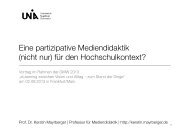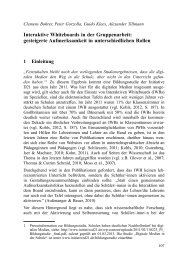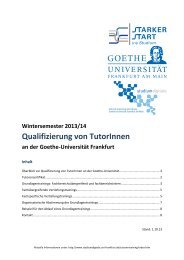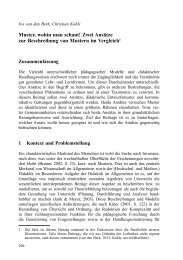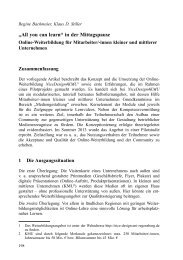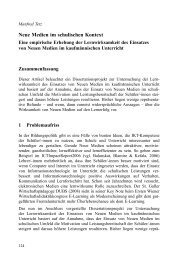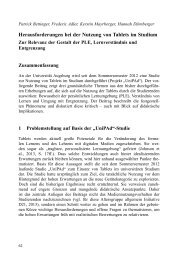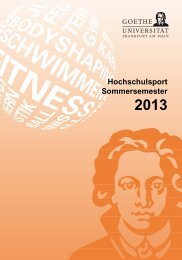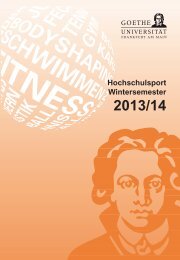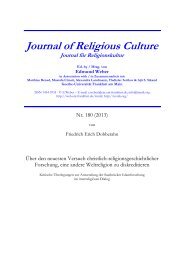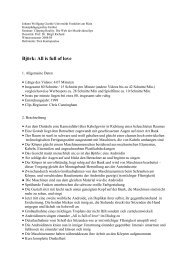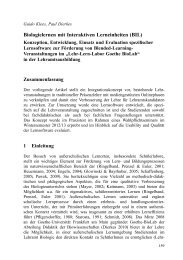Verb second in weil-clauses: Embedded V2 and the syntax ...
Verb second in weil-clauses: Embedded V2 and the syntax ...
Verb second in weil-clauses: Embedded V2 and the syntax ...
Create successful ePaper yourself
Turn your PDF publications into a flip-book with our unique Google optimized e-Paper software.
<strong>Verb</strong> <strong>second</strong> <strong>in</strong> <strong>weil</strong>-<strong>clauses</strong>:<br />
<strong>Embedded</strong> <strong>V2</strong> <strong>and</strong> <strong>the</strong> <strong>syntax</strong>-semantics-pragmatics <strong>in</strong>terface<br />
Mail<strong>in</strong> Antomo<br />
The canonical distribution of <strong>Verb</strong> <strong>second</strong> (henceforth <strong>V2</strong>) <strong>and</strong> V-f<strong>in</strong>al <strong>in</strong> German is as<br />
follows: The f<strong>in</strong>ite verb appears <strong>in</strong> <strong>the</strong> sentence f<strong>in</strong>al position <strong>in</strong> subord<strong>in</strong>ate <strong>clauses</strong> <strong>and</strong> <strong>in</strong><br />
<strong>the</strong> <strong>second</strong> position <strong>in</strong> ma<strong>in</strong> <strong>clauses</strong>. Yet, <strong>in</strong> spoken German <strong>V2</strong>-<strong>clauses</strong> can replace <strong>the</strong><br />
st<strong>and</strong>ard V-f<strong>in</strong>al <strong>clauses</strong> <strong>in</strong> certa<strong>in</strong> well-def<strong>in</strong>ed contexts:<br />
(1) a. Daniel kommt zu spät, <strong>weil</strong> er den Bus verpasst hat.<br />
Daniel comes too late, because he <strong>the</strong> bus missed has.<br />
b. Daniel kommt zu spät, <strong>weil</strong> er hat den Bus verpasst.<br />
Daniel comes too late, because he has <strong>the</strong> bus missed.<br />
The <strong>V2</strong> realisations of <strong>weil</strong>-<strong>clauses</strong> are subject to numerous syntactic restrictions: verb<br />
rais<strong>in</strong>g is blocked if <strong>the</strong> <strong>weil</strong>-clause is clause <strong>in</strong>itial; fur<strong>the</strong>rmore, <strong>V2</strong> is impossible if <strong>the</strong> <strong>weil</strong>clause<br />
is <strong>in</strong> <strong>the</strong> scope of negation or <strong>in</strong> case of variable-b<strong>in</strong>d<strong>in</strong>g by a quantifier. Along with<br />
Uhmann (1998), I <strong>in</strong>terpret <strong>the</strong>se observations as provid<strong>in</strong>g sufficient evidence to treat <strong>V2</strong><br />
<strong>weil</strong>-<strong>clauses</strong> paratactically. Follow<strong>in</strong>g Gärtner’s (2001) analysis of <strong>V2</strong> relative <strong>clauses</strong>, I<br />
propose a paratactic phrase πP whose head π 0 is occupied by <strong>the</strong> conjunction <strong>weil</strong>:<br />
πP<br />
CP1 π`<br />
π 0 CP2<br />
<strong>weil</strong><br />
Hence, <strong>V2</strong> <strong>weil</strong>-<strong>clauses</strong> are syntactically dis<strong>in</strong>tegrated structures s<strong>in</strong>ce <strong>the</strong>y are not element<br />
of <strong>the</strong> matrix CP. Both arguments of <strong>the</strong> conjunction <strong>weil</strong> are full CPs.<br />
<strong>V2</strong> <strong>weil</strong>-<strong>clauses</strong> do not only differ <strong>in</strong> <strong>the</strong>ir syntactic behavior from st<strong>and</strong>ard V-f<strong>in</strong>al <strong>weil</strong><strong>clauses</strong>.<br />
The syntactic differences go h<strong>and</strong> <strong>in</strong> h<strong>and</strong> with systematic <strong>in</strong>terpretational<br />
differences between <strong>V2</strong> <strong>weil</strong>-<strong>clauses</strong> <strong>and</strong> V-f<strong>in</strong>al <strong>weil</strong>-<strong>clauses</strong>. My analysis concentrates on<br />
two ma<strong>in</strong> issues:<br />
a) <strong>the</strong> connection of <strong>the</strong> sentence f<strong>in</strong>al <strong>V2</strong> clause to <strong>the</strong> preced<strong>in</strong>g clause<br />
b) <strong>the</strong> <strong>in</strong>ternal structure of <strong>the</strong> embedded <strong>V2</strong> clause<br />
a): Especially <strong>the</strong> epistemic read<strong>in</strong>g of <strong>the</strong> <strong>V2</strong> <strong>clauses</strong> has drawn <strong>the</strong> attention of numerous<br />
l<strong>in</strong>guists (cf. Uhmann 1998, Wegener 1993). In fact, <strong>V2</strong> <strong>weil</strong>-<strong>clauses</strong> can be <strong>in</strong>terpreted on<br />
<strong>the</strong> illocutionary level <strong>in</strong>stead of <strong>the</strong> propositional one. In this case, <strong>the</strong> causal <strong>V2</strong> clause<br />
gives a reason for <strong>the</strong> speaker’s attitude <strong>and</strong> not for <strong>the</strong> propositional content of <strong>the</strong> matrix<br />
clause. In example (2a), <strong>the</strong> causal clause justifies <strong>the</strong> speaker’s conclusion expressed <strong>in</strong> <strong>the</strong><br />
anteced<strong>in</strong>g clause. If <strong>the</strong> f<strong>in</strong>ite verb appears <strong>in</strong> <strong>the</strong> sentence f<strong>in</strong>al position as <strong>in</strong> (2b), it is<br />
difficult to reconstruct <strong>the</strong> epistemic read<strong>in</strong>g.<br />
(2) a. Es hat geschneit, <strong>weil</strong> die Straße ist ganz weiß.<br />
It has snown, because <strong>the</strong> road is totally white.<br />
b. #Es hat geschneit, <strong>weil</strong> die Straße ganz weiß ist.<br />
It has snown, because <strong>the</strong> road totally white is.<br />
Despite <strong>the</strong> amount of literature about <strong>the</strong> epistemic read<strong>in</strong>g of <strong>V2</strong> <strong>weil</strong>-<strong>clauses</strong>, a conv<strong>in</strong>c<strong>in</strong>g<br />
<strong>the</strong>ory of <strong>the</strong>ir mechanism is still lack<strong>in</strong>g. The aim of my project is to <strong>in</strong>vestigate how <strong>the</strong>
functional properties of <strong>V2</strong> <strong>weil</strong>-<strong>clauses</strong> can be derived from <strong>the</strong>ir syntactic structure. My<br />
analysis focuses on <strong>the</strong> dis<strong>in</strong>tegrated structure of paratactic <strong>V2</strong> <strong>weil</strong>-<strong>clauses</strong>. Carston (2002)<br />
shows that syntactic dis<strong>in</strong>tegration leads to semantic <strong>and</strong> pragmatic dis<strong>in</strong>tegration. S<strong>in</strong>ce <strong>V2</strong><br />
<strong>weil</strong>-<strong>clauses</strong> are not part of <strong>the</strong> matrix assertion, <strong>the</strong> matrix CP doesn’t have scope over <strong>the</strong><br />
causal clause. Be<strong>in</strong>g sufficient detached, <strong>the</strong> <strong>V2</strong> <strong>weil</strong>-clause is <strong>in</strong>terpreted <strong>in</strong> isolation <strong>and</strong> it<br />
can contribute its semantic part at <strong>the</strong> illocutionary level of mean<strong>in</strong>g. Pragmatic enrichment<br />
<strong>and</strong> implicatures are triggered. In contrast, V-f<strong>in</strong>al <strong>clauses</strong> are syntactic constituents of <strong>the</strong><br />
matrix CP. As a consequence, <strong>the</strong>ir mean<strong>in</strong>g cannot apply on a level higher than <strong>the</strong><br />
propositional mean<strong>in</strong>g (cf. Haegeman 2007, Scheffler 2005).<br />
b): <strong>V2</strong> <strong>weil</strong>-<strong>clauses</strong> aren’t an isolated, s<strong>in</strong>gular phenomenon. In certa<strong>in</strong> contexts, object <strong>and</strong><br />
relative V-f<strong>in</strong>al <strong>clauses</strong> can be replaced by <strong>V2</strong> <strong>clauses</strong>:<br />
(3) a. Ich kenne e<strong>in</strong>en L<strong>in</strong>guisten, der kann nicht lesen.<br />
I know a l<strong>in</strong>guist who cannot read.<br />
b. Se<strong>in</strong>e Freunde glauben, es wird morgen regnen.<br />
His friends believe it will tomorrow ra<strong>in</strong>.<br />
The <strong>syntax</strong>, semantics <strong>and</strong> pragmatics of <strong>the</strong>se non canonical sentence types are especially<br />
<strong>in</strong>vestigated by Frank (2000), Gärtner (2001), Gärtner (2002), Me<strong>in</strong>unger (2004), Reis (1997)<br />
<strong>and</strong> Truckenbrodt (2006). The discussion shows two ma<strong>in</strong> issues: The embedded <strong>V2</strong> <strong>clauses</strong><br />
differ <strong>in</strong> <strong>the</strong>ir syntactic behavior <strong>and</strong> <strong>in</strong> <strong>the</strong>ir semantics <strong>and</strong> pragmatics systematically from Vf<strong>in</strong>al<br />
<strong>clauses</strong>; on <strong>the</strong> o<strong>the</strong>r h<strong>and</strong>, all embedded <strong>V2</strong> <strong>clauses</strong> share <strong>the</strong> same syntactic <strong>and</strong><br />
functional restrictions. For <strong>V2</strong> object <strong>and</strong> relative <strong>clauses</strong> it has been shown that <strong>the</strong><br />
movement of <strong>the</strong> f<strong>in</strong>ite verb to C 0 triggers an assertional read<strong>in</strong>g. As a consequence, verb<br />
rais<strong>in</strong>g is blocked if <strong>the</strong> sentence has a presuppositional read<strong>in</strong>g. Though <strong>V2</strong> <strong>weil</strong>-<strong>clauses</strong><br />
are subject to <strong>the</strong> same restrictions as <strong>V2</strong> object <strong>and</strong> relative <strong>clauses</strong>, a transfer of <strong>the</strong>se<br />
results to <strong>V2</strong> <strong>weil</strong>-<strong>clauses</strong> is still <strong>in</strong> order. Hopefully, I will be able to show <strong>the</strong> assertional<br />
nature of <strong>V2</strong> <strong>weil</strong>-<strong>clauses</strong>.<br />
References:<br />
Carston, R. (2002): Thoughts <strong>and</strong> Utterances. The Pragmatics of Explicit<br />
Communication. Oxford: Blackwell.<br />
Gärtner, H.-M. (2001): Are <strong>the</strong>re <strong>V2</strong> relative <strong>clauses</strong> <strong>in</strong> German? In: Journal of<br />
Comparative Germanic L<strong>in</strong>guistics 3, 97-141.<br />
Gärtner, H.-M. (2002): On <strong>the</strong> force of <strong>V2</strong> declaratives. In: Theoretical L<strong>in</strong>guistics 28,<br />
33-42.<br />
Haegeman, L. (2007): Operator movement <strong>and</strong> topicalisation <strong>in</strong> adverbial <strong>clauses</strong>. In: Folia<br />
L<strong>in</strong>guistica 41:279-325<br />
Me<strong>in</strong>unger, A.(2004): <strong>Verb</strong> position, verbal mood <strong>and</strong> <strong>the</strong> anchor<strong>in</strong>g (potential) of<br />
sentences. In: Lohnste<strong>in</strong>, Horst/Trissler, Susanne (ed.), The Syntax <strong>and</strong> Semantics<br />
of <strong>the</strong> Left Periphery. Berl<strong>in</strong>/New York: Mouton de Gruyter, 313-342.<br />
Reis, M. (1997): Zum syntaktischen Status unselbstständiger <strong>Verb</strong>zweit-Sätze. In:<br />
Dürscheid, Christa et al. (Hgg.), Syntax im Fokus. Tüb<strong>in</strong>gen: Niemeyer, 112-144.<br />
Scheffler, T. (2005): Syntax <strong>and</strong> semantics of causal denn <strong>in</strong> German. In: Proceed<strong>in</strong>gs of <strong>the</strong><br />
15 th Amsterdam Colloquium.<br />
Truckenbrodt, Hubert (2006): On <strong>the</strong> semantic motivation of syntactic verb movement to C <strong>in</strong><br />
German. In: Theoretical L<strong>in</strong>guistics 22, 257-306.<br />
Uhmann, S. (1998): <strong>Verb</strong>stellungsvariation <strong>in</strong> <strong>weil</strong>-Sätzen: Lexikalische Differenzierung mit<br />
grammatischen Folgen. In: Zeitschrift für Sprachwissenschaft 17.1, 92-139<br />
Wechsler, S. (1991): <strong>Verb</strong> Second <strong>and</strong> Illocutionary Force. In: Bouchard, D./Leffel, K. (ed.):<br />
Views on Phrase Structure. Dordrecht: Kluwer Academic Publishers, 177-191<br />
Wegener, Heide (1993): Weil- das hat schon se<strong>in</strong>en Grund. Zur <strong>Verb</strong>stellung <strong>in</strong><br />
Kausalsätzen mit <strong>weil</strong> im gegenwärtigen Deutsch. In: Deutsche Sprache 21, 289-235.


